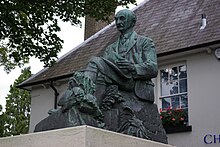Dorchester (Dorset)
| Dorchester | ||
|---|---|---|
| Coordinates | 50 ° 43 ′ N , 2 ° 26 ′ W | |
| OS National Grid | SY690906 | |
|
|
||
| Residents | 16,171 (as of 2001 Census ) | |
| administration | ||
| Post town | DORCHESTER | |
| ZIP code section | DT1 | |
| prefix | 01305 | |
| Part of the country | England | |
| region | South West England | |
| Ceremonial county | Dorset | |
| Unitary authority | Dorset | |
| British Parliament | West Dorset | |
| Website: http://www.dorchester-tc.gov.uk/ | ||
Dorchester is a town in the south-west of the English county of Dorset . It is the administrative center of the county.
Dorchester lies on the River Frome about 35 km west of Poole and about 8 km north of Weymouth . The city has 16,171 inhabitants (2002); around 40,000 people live in the catchment area. On the western outskirts is Poundbury , a model village designed by Prince Charles among others .
history
About 3 km southwest of the city center is on a fort from the Iron Age , Maiden Castle called. It was only when they took this rampart, one of the largest in pre-Roman times, that the Romans and Saxons considered their invasion of Dorset to be successful.
Dorchester itself, originally called Durnovaria , was founded by the Romans in 70. Remains of the Roman city walls and the foundation walls of the town hall have been preserved to this day. On the southern outskirts is Maumbury Rings , a Neolithic stone circle that was used as an amphitheater by the Romans .
In the 17th century Dorchester was a center of the Puritan emigration to North America, which was mainly supported by the Reverend John White (see also Dorchester Company ). Some Dorchester emigrants founded the town of Dorchester , Massachusetts .
After the death of King Charles II , his illegitimate son James Scott, 1st Duke of Monmouth , tried to oust his uncle James II from the throne as Charles's successor. In the course of this Monmouth Rebellion (also Pitchfork Rebellion ) James Scott failed to capture Dorchester and 300 of his people were sentenced to death or exiled by Judge George Jeffreys, 1st Baron Jeffreys . These processes are known as bloody assizes .
Large parts of Dorchester were destroyed by two major fires in 1613 and 1725. Nevertheless find in the city center a few medieval buildings and in the Tudor style built poorhouse .
In 1834 the Tolpuddle Martyrs took place : 6 farm workers founded a farm workers' union in Tolpuddle. Since they did this in the form of a secret society, they were brought to court in Dorchester, because at that time trade unions were already legal, but secret agreements were not. The trial and the verdict of the banishment to Australia sparked protests across Great Britain and there was a petition with 800,000 signatures in Parliament. Through the actions of the trade unions, the government reversed the verdict. It is one of the first lasting events of the trade union movement in Europe. Every year this event is celebrated by the "Tolpuddle Martyrs' Festival" with a march through Tolpuddle.
Attractions
- The writer Thomas Hardy , whose home was Dorchester, designed the fictional place Casterbridge after the model of Dorchester. His house in the city ( Max Gate ) is open to the public.
- Another famous son of the city is Admiral Thomas Masterman Hardy , who served under Lord Nelson's command in the naval battles of Abukir and Trafalgar , among others . In his honor, the 22 m high Hardy Monument stands on a hill in the southeast of the city .
- The Keep Military Museum commemorates regiments that were based in Dorset.
traffic
There are two train stations in Dorchester. The South Western Main Line connects the city with London and Southampton . With the guidelines of the Heart of Wessex Line are Westbury , Bath and Bristol to achieve.
sons and daughters of the town
- Thomas Hardy (1840–1928), writer
- Frederick Treves (1853-1923), surgeon
- Tom Roberts (1856-1936), painter
- Edgar Amphlett (1867–1931), fencer and journalist
- Maurice Evans (1901–1989), actor
- Geoffrey Hutchings (1939-2010), actor
- Michael Francis Perham (1947-2017), Anglican clergyman
- Paul Hillier (* 1949), conductor and baritone
Twin cities
Dorchester signed a town partnership with Bayeux in 1959 , as soldiers of the Dorset regiment liberated the French town from German occupation in 1944. Further twin cities have been Lübbecke in Germany since 1973 and Holbæk in Denmark since 1992 .

